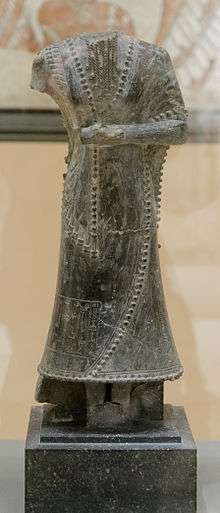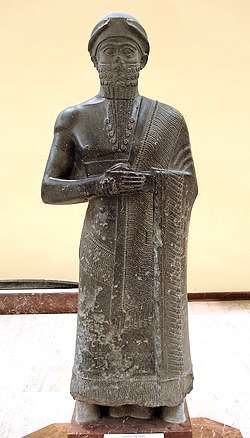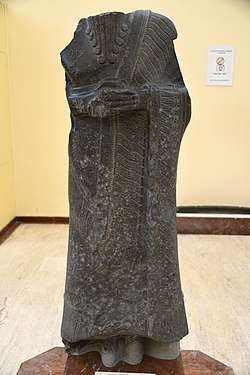Shakkanakku
In the Akkadian language, Shakkanakku, (Sumerian: 𒄊𒀴, GIR.NITA or šagina,[1] Akkadian: 𒇽𒃻𒃶𒅘𒆪), was a title designating a military governor.[2] Mari was ruled by a dynasty of hereditary Shakkanakkus which was originally set by the Akkadian Empire and gained independence following Akkad's collapse.[3] It is considered that the Shakkanakka gained some form of independence and came to be considered as "Kings" from the time of Apil-Kin.[4] A critical analysis of the Shakkanakku List of Mari has been published.[5]

The title is also known around the same time in Elam, where several "Shakkanakku (Military Governor) of the country of Elam" with typically Akkadian names ruled for the Akkadian kings.[6]
The title also existed in Qatna in the 14th century BC,[7] and Dilmun under the Kassites.[8]
Shakkanakkus under the Akkadians
Shakkanakkus, or Shagina military governors are known from the time of the Akkadian Empire. For example, Shar-kali-sharri had a military governor in Nippur taking charge of the construction of the temple of Enlil. One of his year names reads: "Year in which Szarkaliszarri appointed Puzur-Esztar the shagina (general)" to build the temple of Enlil "Year Szarkaliszarri appointed Puzur-Eshtar, the shagina, to build the temple of Enlil".[9][10]
Main Shakkanakkus of Mari
Several Shakkanakkus of Mari are known from archaeological artifacts:
.jpg) Statue of Ishtup-Ilum, Shakkanakku of Mari. (c.2150 BC)
Statue of Ishtup-Ilum, Shakkanakku of Mari. (c.2150 BC) Statue of Iddi-Ilum, Shakkanakku of Mari. (c. 2090 BC)
Statue of Iddi-Ilum, Shakkanakku of Mari. (c. 2090 BC) Puzur Ishtar, Shakkanakku of Mari. (c. 2050 BC)
Puzur Ishtar, Shakkanakku of Mari. (c. 2050 BC) Tura-Dagan, Shakkanakku of Mari. Originally from Mari (c. 2071–2051 BC).
Tura-Dagan, Shakkanakku of Mari. Originally from Mari (c. 2071–2051 BC).
List of Shakkanakku rulers of Mari
| Ruler | Length of reign | Notes | |
|---|---|---|---|
| Ididish | c. 2266–2206 BC | ||
| Shu-Dagan | c. 2206–2200 BC | He was the son of Ididish.[11] | |
| Ishma-Dagan | c. 2199–2154 BC | He ruled for 45 years.[12][13] | |
| Nûr-Mêr | c. 2153–2148 BC | He was the son of Ishme-Dagan.[12] | |
| Ishtup-Ilum | c. 2147–2136 BC | He was the son of Ishme-Dagan and the brother of Nûr-Mêr.[12] | |
| Ishgum-Addu | c. 2135–2127 BC | He reigned for eight years.[12] | |
| Apîl-kîn | c. 2126–2091 BC | He was the son of Ishme-Dagan.[12][14] Was designated with the royal title Lugal in a votive inscription set by his daughter.[15] | |
| Iddi-ilum | c. 2090–2085 BC | His name is also read as Iddin-El; his name was inscribed on his votive statue.[16] | |
| Ili-Ishar | c. 2084–2072 BC | His name is inscribed on a brick.[17] | |
| Tura-Dagan | c. 2071–2051 BC | He was the son of Apîl-kîn and the brother of Ili-Ishar.[18] | |
| Puzur-Ishtar | c. 2050–2025 BC | He was the son of Turam-Dagan.[12] Used the royal title.[19] | |
| Hitlal-Erra | c. 2024–2017 BC | He was the son of Puzur-Ishtar.[20] Used the royal title.[19] | |
| Hanun-Dagan | c. 2016–2008 BC | He was the son of Puzur-Ishtar.[21] Used the royal title.[19] | |
| Isi-Dagan | c. 2000 BC | This name is inscribed on a seal.[22] | |
| Ennin-Dagan | He was the son of Isi-Dagan.[23] | ||
| Itur-(...) | This name is damaged, a gap separate him from Ennin-Dagan.[24] | ||
| Amer-Nunu | This name is inscribed on a seal.[25][26] | ||
| Tir-Dagan | He was the son of Itur-(...).[27] | ||
| Dagan-(...) | This name is damaged and is the last attested Shakkanakku.[28] |
Main Shakkanakkus of Elam
The title is also known around the same time in Elam, as in the inscription of the "Table au Lion", Puzur-Inshushinak appears as "Puzur-Inshushin(ak) Ensi (Governor) of Susa, Shakkanakku (Military Governor) of the country of Elam" (𒅤𒊭𒀭𒈹𒂞 𒑐𒋼𒋛 𒈹𒂞𒆠 𒄊𒀴 𒈣𒋾 𒉏𒆠 kutik-inshushinak ensi shushiki skakkanakku mati NIMki).[6] A ruler with an Akkadian name, Ili-ishmani, at the time of Naram-Sin of Akkad or Shar-Kali-Sharri, also used the same title of "Skakkanakku of the country of Elam".[29][30][31] This suggest that Ili-ishmani was a vassal of the Akkadian Empire.[32]
List of the Shakkanakkus of Elam
| Ruler | Length of reign | Notes | |
|---|---|---|---|
| Eshpum | c. 2300 BC | He was a dependent of the Akkadian Empire ruler Manishtushu.[33] | |
| Ilshu-rabi | c. 2206–2200 BC | Shakkanakku in the Province of Parashime | |
| Epirmupi | c. 2199–2154 BC | ||
| Ili-ishmani | c. 2200 BC | He was in charge of Elam at the time of Naram-Sin and/or Shar-Kali-Sharri, and probably their vassal.[34][35] | |
| Puzur-Inshushinak | c. 2150 BC | Shakkanakku, who gained independence from the Akkadians. He appears as "Puzur-Inshushin(ak) Ensi (Governor) of Susa, Shakkanakku (Military Governor) of the country of Elam".[6] |
References
- "Sumerian Dictionary". oracc.iaas.upenn.edu.
- Gwendolyn Leick. Historical Dictionary of Mesopotamia. p. 113.
- Trevor Bryce. Ancient Syria: A Three Thousand Year History. p. 18.
- Loisel, Anne-Caroline Rendu. "Ilum-Isar et Apil-Kin, deux nouvelles inscriptions de Mari/Tell Hariri". in L. Feliu / J. Llop / A. Millet Alba / J. Sanmartin (ed), Time and History in the Ancient Near East, Proceedings of Rencontre Assyriologique Internationale 56, Barcelone, Juillet 2010, pp.633-643: 650.
- Philological Data for a Historical Chronology of Mesopotamia in the 3rd Millennium (PDF). pp. 26–27.
- Translation into French in Mémoires. Paris: P. Geuthner. 1899. p. 8.
- Gromova 2007, p. 300.
- L. Potter. The Persian Gulf in History. p. 35.
- Douglas Frayne, Sargonic and Gutian periods, RIME E2.1.5, p.184
- Hamblin, William J. (2006). Warfare in the Ancient Near East to 1600 BC: Holy Warriors at the Dawn of History. Routledge. p. 109. ISBN 978-1-134-52062-6.
- Leick 2002, p. 152.
- Oliva 2008, p. 86.
- Leick 2002, p. 81.
- Leick 2002, p. 18.
- Michalowski 1995, p. 187.
- Leick 2002, p. 76.
- Leick 2002, p. 78.
- Leick 2002, p. 168.
- Oliva 2008, p. 91.
- Oliva 2008, p. 92.
- Leick 2002, p. 67.
- Frayne 1990, p. 594.
- Frayne 1990, p. 596.
- Frayne 1990, p. 597.
- Oliva 2008, p. 87.
- Frayne 1990, p. 598.
- Frayne 1990, p. 599.
- Frayne 1990, p. 600.
- "CDLI-Archival View". cdli.ucla.edu.
- Álvarez-Mon, Javier (2020). The Art of Elam CA. 4200–525 BC. Routledge. p. 216. ISBN 978-1-000-03485-1.
- "Site officiel du musée du Louvre". cartelfr.louvre.fr.
- Potts, D. T. (2016). The Archaeology of Elam: Formation and Transformation of an Ancient Iranian State. Cambridge University Press. p. 100. ISBN 978-1-107-09469-7.
- Álvarez-Mon, Javier (2020). The Art of Elam CA. 4200–525 BC. Routledge. p. 209. ISBN 978-1-000-03485-1.
- Álvarez-Mon, Javier (2020). The Art of Elam CA. 4200–525 BC. Routledge. p. 216. ISBN 978-1-000-03485-1.
- Potts, D. T. (2016). The Archaeology of Elam: Formation and Transformation of an Ancient Iranian State. Cambridge University Press. p. 100. ISBN 978-1-107-09469-7.
Sources
- Gromova, Daria (2007). "Hittite Role In Political History of Syria In the Amarna Age Reconsidered". Ugarit-Forschungen. Ugarit-Verlag. 39. ISBN 978-3-86835-001-2.CS1 maint: ref=harv (link)
- Leick, Gwendolyn (2002). Who's Who in the Ancient Near East. Routledge. ISBN 978-1-134-78796-8.CS1 maint: ref=harv (link)
_Mari-ki.jpg)